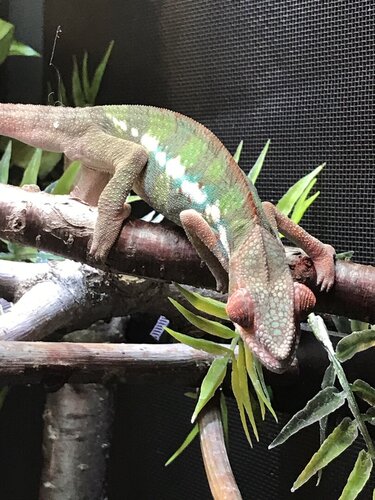Navigation
Install the app
How to install the app on iOS
Follow along with the video below to see how to install our site as a web app on your home screen.
Note: This feature may not be available in some browsers.
More options
You are using an out of date browser. It may not display this or other websites correctly.
You should upgrade or use an alternative browser.
You should upgrade or use an alternative browser.
Modifying the mineral profile of crickets (Acheta domesticus) using a supplemented diet...
- Thread starter kinyonga
- Start date
DocZ
Chameleon Enthusiast
I think it’s interesting stuff. After reading some other similar research, I have been adding a little Herptivite to my gut load. I stopped adding calcium after I had read about the constipation and death in the feeders. I did lose a few crickets when I was consistently adding calcium to their diet, but no Dubia, discoids, or superworms died.
Previous research showed linear relationships between calcium supplementation and feeder Ca content in crickets and silkworms.
I decided to stick with vitamin supplements in the gut load along with spirulina and chorella algae powder, but removed the calcium to avoid feeder losses.
I’m still confused about which form of Vit A is best for chameleon bioavailability
Previous research showed linear relationships between calcium supplementation and feeder Ca content in crickets and silkworms.
I decided to stick with vitamin supplements in the gut load along with spirulina and chorella algae powder, but removed the calcium to avoid feeder losses.
I’m still confused about which form of Vit A is best for chameleon bioavailability
@Do Z said..."I’m still confused about which form of Vit A is best for chameleon bioavailability"...me too. For years I only used beta carotene sources for veiled chameleons and they seem to be fine with that. Panthers also seemed to be fine with it I think. The "safest" may still be to cover all bases by giving s little prEformed once in a very long while and then using beta carotene most of the time.
DocZ
Chameleon Enthusiast
I’m an anesthesiologist. So I don’t know anything about chameleon biology, just biology in general. And thus I don’t mind researching a topic, and love it when there’s scientific studies to examine and alter my practice with
I’ve really enjoyed how this community has banded together to maximize the quality of life of these amazing animals. There are major gaps in the scientific evidence for “ideal care”, but you all have combined your years of experience, successes, and failures to give chameleons the care and respect they deserve.
Providing appropriate living conditions for chameleons is neither simple nor inexpensive. I feel like nutrition is an area that can somewhat protect any animal under less than ideal living conditions by giving it the strength to endure extra stress. Thus, I’m really interested in making sure my chameleon is getting the best nutrition I can provide in the event some sort of environmental stress occurs (right now I seem to be his biggest stress ?). I’m striving to ensure his living conditions are also ideal
I’ve really enjoyed how this community has banded together to maximize the quality of life of these amazing animals. There are major gaps in the scientific evidence for “ideal care”, but you all have combined your years of experience, successes, and failures to give chameleons the care and respect they deserve.
Providing appropriate living conditions for chameleons is neither simple nor inexpensive. I feel like nutrition is an area that can somewhat protect any animal under less than ideal living conditions by giving it the strength to endure extra stress. Thus, I’m really interested in making sure my chameleon is getting the best nutrition I can provide in the event some sort of environmental stress occurs (right now I seem to be his biggest stress ?). I’m striving to ensure his living conditions are also ideal
DocZ
Chameleon Enthusiast
I was under surveillance today while doing some cage improvements (hopefully Calcifer thinks it’s improved)
Attachments
I think it is.Thanks. Why beta carotene most of the time and preformed occasionally? Is this safest to avoid over-supplementation?
The beta carotene is safe whether they can convert it or not because the body only converts what it needs. So ...this keeps people from overdosing vitamin A if they happen to use the vitamins too heavily. And since my vitamin also has NO D3 in it (I use the calcium/D3 to provide the D3) it lowers the risk IMHO of overdosing the D3 too. It then leaves it up to the owner to decide if/when their chameleon needs vitamin A...whichnImhole makes them think about it a bit more.
You also need to balance the vitamin A and D3 because they are somewhat antagonistic to each other and an imbalance can lead to a form of MBD.
Congratulations on being an anesthesiologist! Anesthetizing chameleons seems to be interesting! I know a little bit about it!
@DocZ ...you might be in this information...
This one contains most of what I know about anesthesia in chameleons...
https://www.vetfolio.com/learn/article/anesthesia-and-analgesia-in-reptiles
Isoflurane and sevoflurane were two of the ones used most with my chameleons.
Another one...
https://cdn.ymaws.com/arav.site-ym.com/resource/resmgr/Files/Proceedings_2011/2011_049.pdf
This one contains most of what I know about anesthesia in chameleons...
https://www.vetfolio.com/learn/article/anesthesia-and-analgesia-in-reptiles
Isoflurane and sevoflurane were two of the ones used most with my chameleons.
Another one...
https://cdn.ymaws.com/arav.site-ym.com/resource/resmgr/Files/Proceedings_2011/2011_049.pdf
DocZ
Chameleon Enthusiast
These are great thanks. Im definitely interested in reading about induction/maintenance of anesthesia and physiologic monitoring
I’ve been eyeing Mader’s Reptile and amphibian medicine and surgery too. Probably will pick that up so I can dive deeper into reptile medicine
I’ve been eyeing Mader’s Reptile and amphibian medicine and surgery too. Probably will pick that up so I can dive deeper into reptile medicine
Similar threads
- Replies
- 0
- Views
- 581
- Replies
- 0
- Views
- 739
- Replies
- 2
- Views
- 628
- Replies
- 6
- Views
- 2K








